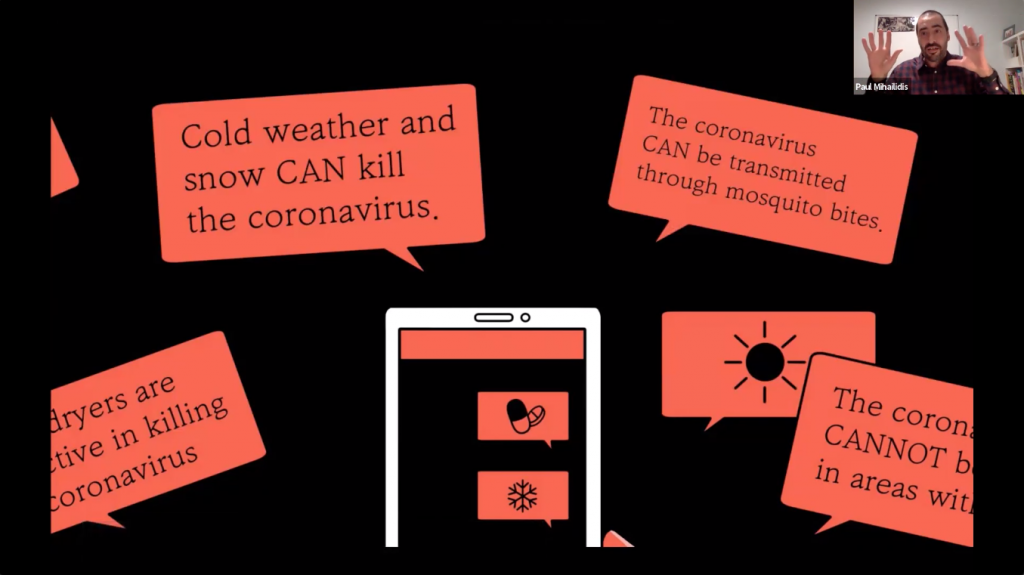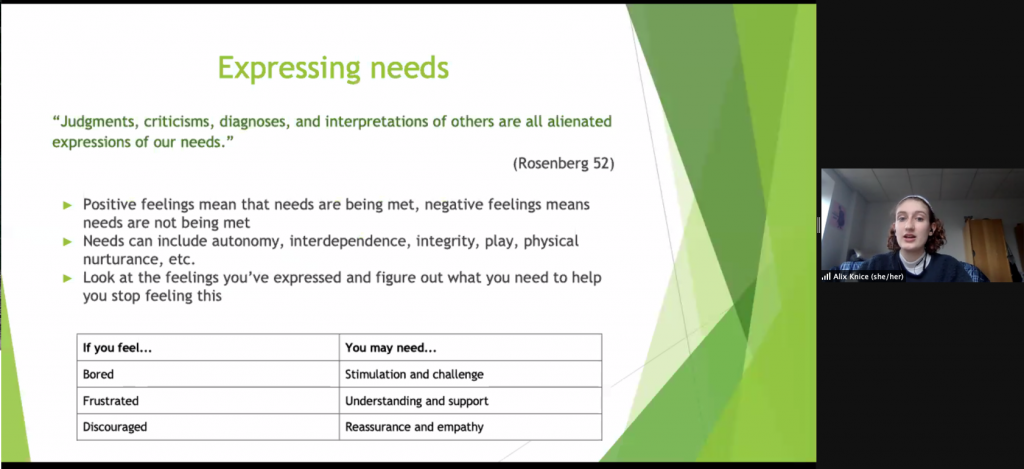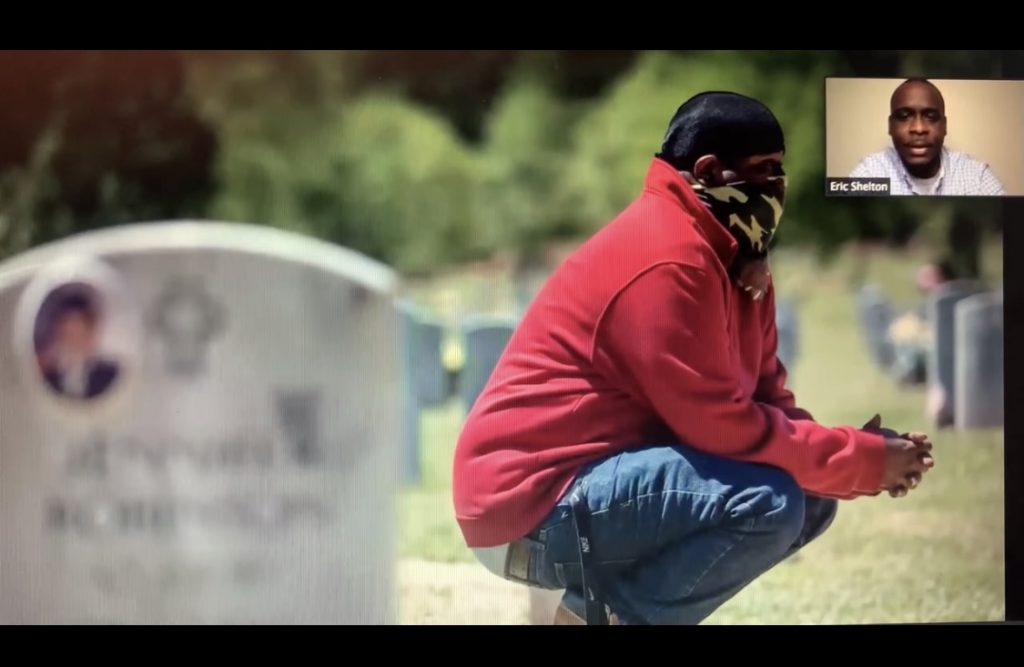CommDay 2021: What We Learned. Where We Go from Here.

The School of Communication recently hosted its annual Communication Day, exploring the dynamics of a year impacted by an unrelenting pandemic, a faltering economy, virulent politics, and renewed urgency for social justice.
In a typical year, the event would have been spread over two days and across campus. In 2021, “CommDay” was condensed to five hours and nine sessions led by faculty from across the school’s four academic departments. They explored how the the content, tenor, and channels of communication have changed (for better or worse), how we seek to connect, and to hear and be heard more effectively.
School of Communication Dean Raul Reis connected the inspiration for the 2021 CommDay back to the beginning of the pandemic, and the “very unique summer in which racial inequalities and economic disparities burst to the surface in a way that made us question, even more, the way we live, the way we think, the way we teach and learn.
“Here at the School of Communication, as we started living in this phase that we got used to calling ‘the new normal,’ we also got to thinking about the ways in which our mission and our daily lives have been affected. We are looking at today as an opportunity for us to reflect on the lessons we have learned this past year and especially to reflect on the opportunities we all have to build a better future.”
We’re sharing just a small part of the highlights and insights of the day, as well as links to some of the session recordings. You can find additional highlights of the day in the Stories of the SOC Instagram page.
OPENING SESSION: Communication in 2021: What have we learned? Where do we go from here?
Concept: In many ways, the events of the past year have been defined or influenced by how we communicate—in the media, among businesses and organizations, and between each other. In some ways, communication has changed us, and in others, we have changed how and what we communicate. But this is not new, as society has navigated intense periods of change before. Panelists from different communication fields will draw from experience and events of the past year to discuss how we have navigated change in the past, and what we might expect in the future.
Panelists:
- Dean Raul Reis, Moderator
- Robin Danzak, Associate Professor, Communication Studies and Disorders
- Carol Ferrara, Assistant Professor, Marketing Communication
- Kenneth Grout, Executive-in-Residence, Communication Studies
- Azeta Hatef, Assistant Professor, Journalism
Question: As the boundaries between work and life have become blurred, will we have to come up with new and healthy boundaries?
Robin Danzak: “In some ways, we are bound by social distancing and having to spend more time at home. Having more of our interactions in an online format like this one does give us some limitations, right? But at the same time, remote engagement invites us into each other’s spaces in ways that we didn’t have before. Rather than having a shared workspace, we’re now all sharing our home spaces. For example, all of my students know our dog and cat, which they probably wouldn’t if we weren’t having our classes online.”
Is it healthy to erase the boundaries between work and life? Will we need to create new boundaries in the future?
Kenneth Grout: “We can think of many boundaries, and one that merits some focus is the boundary of time. We are a society that—at least the American society—focuses heavily on planning. All of a sudden, when we think six months out, we almost have to stop ourselves because we’re not sure what life is going to be like then. So the opportunities in the future are really about keeping our eyes open, keeping our ears open, and being willing to reshape the boundaries a little bit as we go.”
Will we become over-reliant on technology?
Carol Ferrara: “This is something we talk about a lot in really all of my classes, and I think what’s really important is to recognize that even if we don’t have all the answers in terms of how to solve these problems, I think one of the most important things we can do for our students is raise that awareness. We read a lot about the addiction of social media and how it works with our dopamine systems in our brains so that students are aware of what’s happening to them when we use social media. Once you’re aware of it, you can’t be unaware of it. So every time you pick up your phone, you start to think, ‘OK, well do I really want to do this right now? Is this going to make me feel better?’ The goal here is not for students to let go of their Instagram accounts. Social media has given us privileges to cross boundaries with new ways of communication. The most important thing is just to learn responsibility. As an anthropologist, I have hope that once we are able see each other again in a full kind of way, we might be more persuaded to put down our phones. So I’m hoping.”
Azeta Hatef: “It’s important to think about how technology — especially social media — fosters human connection. But we are talking about accessibility. There’s a reckoning, very rightfully so, taking place within newsrooms across the country, but also within journalism education about how we cover topics of race, gender, sexuality, and more broadly, marginality. This is not the first time we’re having conversations around things like objectivity. These debates will continue on and on. What becomes really important for us to ask and really reflect upon is that, ‘Are we encouraging ourselves to reimagine journalism in a way that truly serves all people?’”
Local News Lifeline: In Chaos Reborn
Students continually hear about the death of local news as they consider their future working options. But there is dramatic evidence everywhere that local news is reasserting its lifeline during times of trouble and reinventing itself in new digital forms to serve underrepresented communities. In this session, journalists from Texas news outlets and ProPublica discussed extraordinary measures taken to report on the recent weather-related catastrophe there and reassert the lifeline importance of local media, even as its existence is increasingly threatened. In addition, Boston-area community journalists discussed the nonprofit local challenges of providing and sustaining critical services and information to their underserved readers, while Rick Edmonds of the Poynter Institue provided an inside take on the changing face of local media.
Panelists:
- Diane Mermigas, Affiliated Faculty, Journalism
- Gino Canella, Assistant Professor, Journalism
- Zahira Torres, Senior Editor, ProPublica
- Corrie MacLaggan, Managing Editor, Texas Tribune
- Erin Douglas, Reporter, Texas Tribune
- Rick Edmonds, media business analyst, Poynter Institute
- Jason Pramas and Shira Laucharoen, Boston Institute for Nonprofit Journalism and the Somerville News Garden
Erin Douglas (regarding the severe winter storm that hit Texas in 2021): “I cannot overstate how helpful it was to have leadership of the organization, making sure that they knew where all the other reporters were and where the editors were, and who was going to be editing me that day, and who I was going to be working with that day, what storyline I needed to follow that day. They were doing a lot of work on the organizational side of things, and making sure I felt like I could do work without having to work where my team members were and if they were safe.”
Jason Pramas (on renewed interest in community-based journalism in Massachusetts): For years, city after city ha[s] been going dark with community news. When we launched the Somerville News Garden, we thought we had to do community organizing along with journalism. But when we held our first meeting with the citizens of Somerville to discuss their interests in community journalism, 130 people and 22 organizations showed up. There is a need and demand for news reporting that serves local communities.”
When Facts and Feelings Collide: Case Studies in Confirmation Bias and Digital Culture

Vaccines cause autism. Humans have nothing to do with climate change. Media are lying ALL THE TIME. Stories like these circulate on social media every day. And the more they are repeated, the more they seem true. Even if we are skeptical, it is difficult to find the facts through so many layers of rhetoric. Or quell that nagging “what if?” feeling. The session examined case studies, discussed how some narratives come to dominate the conversation, and how to follow the threads of original data to get beyond feelings and into facts.
Discussion Leaders:
- Ruth Grossman, Associate Professor and Chair, Communication Sciences & Disorders
- Paul Mihailidis, Assistant Dean, Associate Professor of Journalism, Graduate Program Director for Media Design
Paul Mihailidis: “When you see the types of disinformation—political and economical motives, safety and whether vaccines are effective or needed, conspiracy theories, liberty and freedom—these things are quite pervasive in terms of their engagement and resonance. And they often crowd out the space we have for truth, reporting, and credibility.”
SmartPhone StoryFest: The Secrets of Great Storytelling with a SmartPhone
At this very moment you most likely have the two key ingredients needed to craft an amazing digital story: your brain and a smartphone. SmartPhone StoryFest empowers everyone to get in touch with the narrative skills and craft a story in a festival-like atmosphere. In this presentation and workshop, panelists unveiled some secrets of creating great stories along with how to use a smartphone to bring that story to life. This session also featured the launch of the SmartPhone StoryFest competition, culminating in four prize awards for participating students.
Panelists:
- Mark Brodie, MA ’99, Affiliated Faculty, Communication Studies
- Gina Gayle, Assistant Professor of Journalism
- Ulya Aviral, MFA ’17, Affiliated Faculty, Visual Media Arts
Gina Gayle: “You take the audio, you take the still photos, you take the video, you take text, graphics, and music…And you put them into this story. What we have to really find out is, which medium best fits the story? Which part of the story is going to be best told in audio, that can’t necessarily be told in stills or video? What is going to be best told with a still photo—that decisive image that makes us just want to stop and stand there in that moment? What part of the story is going to resonate with your audience?”
Team Harmony: Eradicating Hate
Even in the era of COVID, civic engagements continued to occur globally in an effort to eradicate hate. President Pelton asked the Emerson community what it was doing to eradicate hate. Faculty and students responded, collaborating with The Rendon Group. They hosted monthly webinars working with 130 student reporters from around the globe, established the Virtual Institute for Activism where 15 Emerson faculty members teach various courses, and they created an Activism Tool Kit. This program exemplifies the power of communication and the human spirit to work together on a common goal even in such dire times.
Panelists:
- Mark Brodie, Affiliated Faculty, Communication Studies, Team Harmony series producer
- Cathryn Edelstein, Senior Executive-in-Residence, Communication Studies
- Khary Higgins ’21, Sports Communication, Team Harmony series Co-Host
- Angel Salcedo ’21, Journalism, Team Harmony series Co-Host
- Elli Barkett, The Rendon Group
- Gregory Payne, Associate Professor and Chair, Communication Studies
Khary Higgins (on co-hosting a global webinar series): “My favorite episode might have been our focus on the arts .We had musical artists like Big Sean and T.I. talk about how the arts can influence social justice. One of the most important things about Team Harmony is that it’s really intentional with the stories and public figures that we bring in to discuss different topics. It’s very comprehensive in terms of giving people access to different perspectives.”
Mark Brodie: “My contribution was working from the start with a considerable number of people to figure out how can we put together various programs that would make a difference? And then once we had the outline, go and find the people who can make it happen—like Ellie, like Khary, like Angel. And one of the real blessings of being an Emersonian and having a school where we specialize in communications—it’s not that difficult to find legitimate talent that really cares about social issues, such as what we address at Team Harmony.”
Streaming Wars: Diversity & Inclusion
Companies like Disney, Netflix and Amazon are fighting to gain market share in overseas markets as the North American market approaches saturation. Will this competition spur inclusion and cultural diversity due to geographic, ethnic and linguistically diverse origins, or simply be powerful new channels for American content? Will these businesses be able to achieve scale outside the borders of North America? What will international audiences find subscription-worthy and at what price points? Which companies and brands will prove sustainable over time?
Panelists:
- Robert Lyons, Executive-in-Residence, Marketing Communication
- Naa Amponsah Dodoo, Assistant Professor, Marketing Communication
- Russell Newman, Associate Professor, Marlboro Institute for Liberal Arts & Interdisciplinary Studies
Robert Lyons: “When we look at streaming services, it’s important to note the corporate parents of these companies. Several, such as Amazon Prime, Apple TV+ and the Disney+ bundles are owned by tech companies whose revenues do not come from streaming. In fact, most of their business has nothing to do with streaming. Others are owned by companies with legacies in the cable TV and Internet markets. Netflix is the only pure player in the whole array. So when we look at corporate parents, a whole bunch of questions arise, including who is making the content decisions at these places.”
Naa Amponsah Dodoo: “Arguably, if you think of Netflix and Orange is the New Black, that may have set off the desire for all these different companies to have and produce diverse original content because they appeal to a wide variety of consumers. If we think about what happened last summer with regard to social and racial issues, some if not all of the streaming platforms put their foot forward in terms of supporting particular social issues. For example, Disney+ and Netflix launched content collections that were meant to highlight the Black experiences and Black content creators. Each of these companies have their own ways of making sure they provide content that is diverse for everybody.”
Russell Newman: “Communication policy determines three things. One, what am I going to find on some particular medium of communication? Two, who’s going to have access to means of communication (such as broadband access) going forward? Three, what can I do aboard these mediums of communication? We’re in the midst of a bunch of sea changes in policy that have everything to do with how streaming platforms are going to operate, your interactions with them, and—as an Emerson student who’s going out to get involved in media production—how hard or easy might it be to start up your own service if you don’t want to play with one of the big dogs?”
Communicating with Compassion Workshop

How can we create more meaningful, compassionate, and positive human relationships? Nonviolent communication (NVC), as developed by Marshall Rosenberg, is rooted in the premise that human violence results from misguided attempts to meet needs. It provides guidelines for treating ourselves and others with empathy, equality, and regard. In this workshop Professor Phillip Glenn and his students introduced participants to four core NVC practices: making non-judgmental observations, expressing feelings, expressing needs, and making requests. Workshop participants gained valuable skills for communicating compassionately in professional and personal settings and heightened appreciation for the power of positive communication to enrich human relationships.
Panelists:
- Phillip Glenn, Professor of Communication Studies
- Alix Knice ’22, Communication Studies
- Mary Kuczkowski ’22, Communication Studies
- Hallie Parrott ’21, Communication Studies
- Grace Tepper ’21, Political Communication
Alix Knice (on expressing needs): “If you’re bored, you may need stimulation and challenge. If you feel frustrated, you may need understanding and support. If you feel discouraged, you may need reassurance and empathy. These may all seem like very abstract ideas for something you could need, but your needs are also able to be concrete, You could need space, or alone time, or you could need a friend only to discuss a topic involving your personal life when you personally bring it up. Needs are going to be different for every situation and every person, so make sure you think about this thoroughly… If I feel the need to approach someone, I try to prepare and think about my needs ahead of time.”
Grace Tepper (on making requests): “When saying to someone, ‘You need to do this right now,’ and they either say ‘yes’ or they say ‘no,’ there’s no collaboration in that, it’s just a cold-hearted answer either way. So that makes it very hard for you to work with someone in a more diplomatic way, in a more peacefully engaging way, rather than just demanding something, and likely not really getting what you’re demanding in the end because of the way that you phrased it.”
COVID through the Viewfinder: Are Photojournalists Essential Workers?

Traditionally, photojournalists were considered story illustrators rather than reporters in the field, yet photographers were often called upon to “get the picture” no matter the circumstances. This year, photojournalists have provided a compelling visual record of trauma, discord, and moments of grace that has defined this unprecedented national crisis. In this session, two photojournalists presented their work from the past year to discuss their approaches to covering major events in 2020 including a presidential election, social protests, economic fallout, and a global pandemic. Each shared stories of how they navigated their own safety while on assignment, followed by a Q&A discussion with the audience.
Panelists:
- Joanne Ciccarello, Affiliated Faculty, Journalism
- Gina Gayle, Assistant Professor, Journalism
- Elizabeth Gillis ’15, NPR Visuals Editor, Washington DC
- Eric Shelton, Visual Journalist, Clarion Ledger (Jackson, Mississippi)
- Erin Clark, Visual Journalist, Boston Globe
Erin Clark (on going into the hospital for the first time during the pandemic): “I think the first time I was, I don’t want to say frightened— I was very aware of the potential risk. My main concern was going into the hospitals. I was excited to have the opportunity to be able to go and document what was happening. So my main concern at that time was I had two roommates, so I was really trying to figure out whether or not they’d be okay with that. It kind of just came down when they moved in, they knew they’d be living with a photojournalist, but perhaps they didn’t know they’d be living with a journalist during a pandemic, so it’s a little different!”
The Key Ingredient to Success: Taming the Fear of Failure
A panel discussion that aimed to dispel the fears that students and faculty might have about failure. In extreme cases, the fear of failure actually has a name: atychiphobia. We’re talking about failure as it manifests in every discipline and profession. There are huge benefits to failing, life-long lessons, and ultimate successes from the newfound confidence you’ll enjoy.
Panelists:
- Lynn Conners, Director of Clinical Programs, Communication Sciences & Disorders
- Deion Hawkins, Assistant Professor, Communication Studies
- Janet Kolodzy, Professor and Chair, Journalism
- Wes Jackson, Executive-in-Residence, Director, Business of Creative Enterprises
- Lu Ann Reeb, Senior Executive-in-Residence, Director, Entrepreneurial and Business Studies
- Brent Smith, Professor and Chair, Marketing Communication
Janet Kolodzy: “The reality is that there is never enough time, there are always way too many people, and there’s always way too many ways that you can write something. So part of what I like in dealing with failure is to say, ‘You didn’t fail if you did the work. If you got the story – it may not be perfect, but you didn’t fail.’”
Deion Hawkins: “I would encourage you all to focus on learning and growth, and don’t expect perfection. Also, don’t compare your Chapter 13 or someone else’s Chapter 13 to your Chapter 3, right? A lot of failure happens when we see what other people are doing, but as we have all kind of discussed, failure and success are going to be determined at the individual level. And that goes back to the idea of managing the expectations. That person may have more support, that person may have more resources—there are other factors that may be contributing to that than just your individual talents. So I would really encourage everyone, and I know it’s hard, but get to the point where you feel so confident in what you do that you say, ‘That person is great, but I’m also confident in what I have to offer as well.’”
Lynn Conners: “We see really rigid adherence to ‘the plan.’ It’s sort of the manifestation of fear of failure: ‘It has to go the way I scripted it, and if it doesn’t, oh, I just can’t go there,’ right? And no believe me, a well-executed plan can be a thing of beauty, but if you create space with flexibility for other, be it client or peer, or mentee, or whoever it may be —that combination of your plan and their contributions to you is frightening because it’s unknown and it’s unscripted. But that’s where the growth comes. That’s where the development and the magic is.”
Brent Smith: “One of the races I hated running was hurdles. Loved doing 100 meter, but my track coach said, ‘Hey Smith, let’s try those hurdles.’ So I say this, rather than have a fixed mindset, just keep trying the things you know you’re good at, have a little courage, trust yourself enough that you can get through failure. If you can’t jump the hurdles, hit the hurdles, but finish the race. And don’t run to the finish line, run through the finish line. And just like you’ve seen on the news every once in a while where someone can’t quite finish the race by themselves—when you see somebody who can’t quite get there by themselves, don’t you let them fail, because that’s your failure also. You go out there, and you help them put their arm around your shoulder and you walk them through the finish line because you understand what they’re trying to do. So when we see people trying to succeed, let’s not let them fall short. Let’s get them through the finish line.”
Categories